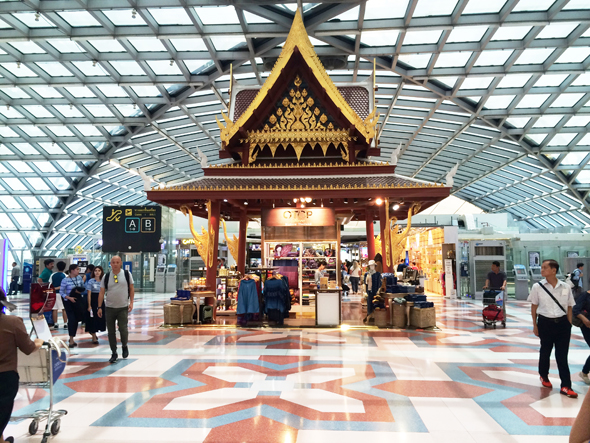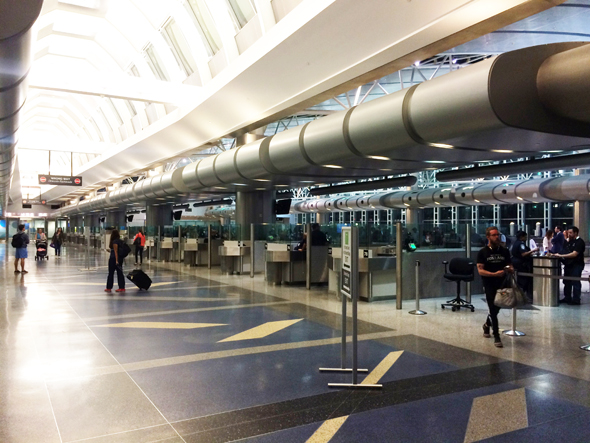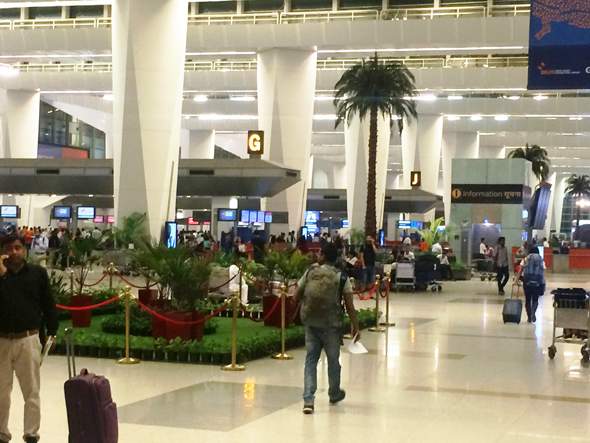Among International Airports, IAH is a Dismal, Dreary Experience
Saved under Community, Current Stories, Travel
Tags: Baytown, Clear Lake, Cypress, Desi news, Greater Houston, Houston, Houston Desi news, India, Indian American community, Indian News, Indians in America, Indira Gandhi Airport, Indo-American News, Katy, NRI, pearland, south asia, South India, Sugar Land, Suvarnabhumi Airport, Texas, USA
By Jawahar Malhotra
HOUSTON: It had been a good six weeks of traveling for me between five countries (including the US), ten cities and 17 flights and I had endured the usual frustrations of those who are prepared for the uncertainties of air travel.
For instance, at Suvarnabhumi International Airport in Bangkok, I realized that I hadn’t printed out the approval email for my visa to enter Myanmar (Burma) so I wasn’t allowed to check in for my Thai International Airways. The youngish Thai counter representative pointed with his fully outstretched arm towards the back of the airport and stammered in heavily accented and fragmented English “print out, yah, you can go to internet café”.
I followed his hand and gaze, loaded my bags onto the trolley and took off to the back wall, 2,000 feet away, asked some more directions and found the only internet café, tucked into a corner next to the post office. They wanted 100 baht ($3) for 15 minutes of internet but wouldn’t take dollars and pointed to an ATM, but I wound up at the foreign exchange booth a few stalls down. I had to pay an extra 10 baht per page for a printout. Armed with the printed approval, I traversed back to Aisle H and checked in to my flight Suvarnabhumi Airport’s International terminal is cavernous and about ten years old; I first came here a year after it had opened and found it an experience to remember, although I fondly recall the old one where I had once burnt my mouth on a quick lunch of chilli chicken which was so hot I lost my hearing for 30 minutes! The Thais pride themselves on their history, culture and sense of interior design, as one can imagine from visiting any Thai restaurant, and the Concourse is nothing more than a visual treat of statuary, models of pagodas, homage to their monarch, color, enticingly laid out duty-free shops, restaurants, music and plants – all that a hub-bub of international travelers crisscrossing between appealing gates would need. Even the immigration counter, which is always crowded with a continuous stream of people, works fast and the Thai military in khakis (no guns) quickly move along the visas on arrival.
Up and down the Asian landscape, at major world class cities, I found other airports with a similar approach to showcasing the cultural and commercial aesthetics to engross the traveler, from Beijing, to Shanghai, Hong Kong, Singapore, Djakarta, – even tiny Yangon, Ho Chi Min City and Phom Phen – and now to that add New Delhi (with the cheapest duty free shops on the planet), Mumbai and Chennai. Only Ninoy Aquino Airport in Manila is an ugly mess, designed around American styles.
I knew what to expect when I got back to the George Bush Intercontinental Airport in Houston, but still was appalled and taken aback by the blandness, utilitarianism and grey interiors of the arrival area; a stark contrast to the colorful and other enticing terminals I had visited. It was a long dreary walk through uninviting, white painted corridors to a large hall where pedestals with draw ribbons broke the space into a maze of twisting lines. At 4pm, the hall was full of incoming travelers and many of the checking booths were not manned. The lighting, ambiance and somberness of the space was only broken by a cheerless sign reading “Welcome to the US” though the other signs admonished you not to use cell phones and other precautions.
In contrast to the other airports I had just visited, there was no special booth set aside for travelers needing special assistance, like my mother in a wheelchair, and the IAH representatives blew off my entreaties to hurry things along, telling me that this should be taken up with the Homeland Security officers. I reminded them that it was their airport building that they should have it better organized and they looked away.
Over an hour later, we walked up to the immigration check point, where the overweight, middle-aged officer was only interested in quickly getting off his long shift. He was dressed like all the other officers in a dark blue shirt with insignia on the arms, a badge, rank bars on the shoulder lapels, black pants and a gun on his hip, attached to a shiny belt with spare bullets in the back. I wondered what kind of welcome this was, or if we were being processed to go to a concentration camp by the para-military! The walk past customs was the same experience, except the officers had white shirts and casually waved us through, though last year we were asked to have each bag x-rayed and examined, which took another tedious 30 minutes.
Fifty years ago, when Houston was still a cow town, Hobby Airport didn’t even have an immigration clearance area. That all came after the Big Airport was made ten years later. In the ensuing 40 years, the city has been fortunate to have enticed many international carriers to the airport but has limped along in providing the allure for travelers. But whereas the prestige of having some world-renowned airlines – like Emirates, Singapore and Lufthansa – touch down here with direct flights are certainly feathers in the city’s cap, the ground experience that travelers receive is abysmal, starting with the immigration hall.
It is even more ironic given that most Houston business leaders and politicians usually go to great pains to point out that this is “the most diverse city in the US” but have not tapped into the imagination and perspectives of this huge international group to develop a truly alluring international terminal that would be world-class and rank with the other airports across the globe. Instead, Houston’s facility looks and operates more like it was of a developing country. Alas, the same could be said for all the other facilities for tourists that should – but don’t – exist in the Bayou City.




